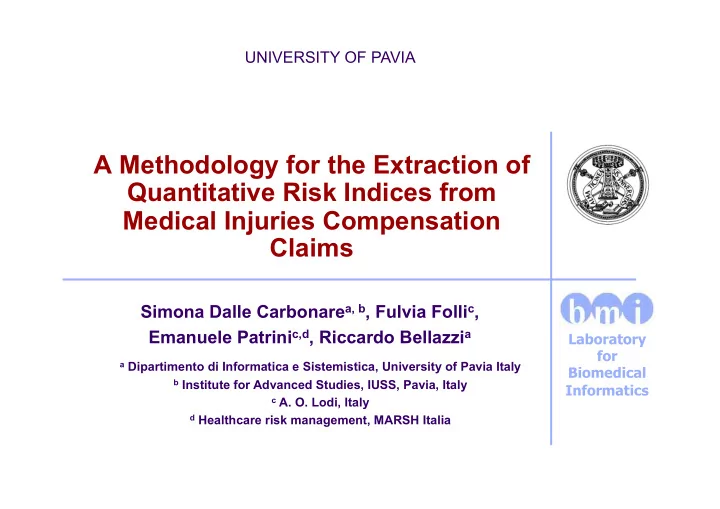

UNIVERSITY OF PAVIA A Methodology for the Extraction of Quantitative Risk Indices from Medical Injuries Compensation Claims Simona Dalle Carbonare a, b , Fulvia Folli c , Emanuele Patrini c,d , Riccardo Bellazzi a Laboratory for a Dipartimento di Informatica e Sistemistica, University of Pavia Italy Biomedical b Institute for Advanced Studies, IUSS, Pavia, Italy Informatics c A. O. Lodi, Italy d Healthcare risk management, MARSH Italia
Agenda ! Topic introduction ! Actuarial Model ! Methodology description ! Variables ! Steps ! Extracted risk indices ! Application to real data ! Results ! Conclusions
Introduction One of the main goals of risk management in health care is to lower the frequency and the impact of the adverse events Analyze the medical injuries compensation claims Learn the main reasons causing the adverse events happening Properly negotiate Plan actions the contract with to mitigate risks insurance companies
Methodology Proposed Methodology based on the actuarial model to obtain quantitative risk indices from compensation claims All data (claims) Global analysis Stratified analysis Revise Risk Management insurance policy activities
Actuarial Model Frequency F Severity S Monte Carlo Convolution Simulation Number Impact of of event the event occurrences Estimated Losses L
Model Variables Severity Frequency Continuous Discrete Reimbursement of Number of claims the claim ( € ) in a given time interval
Methodology Steps Estimation of frequency 1) and severity distributions Monte Carlo simulation to 2) estimate the losses distribution 3) Risk indices extraction
1) Distributions Estimation Parametric fitting Frequency Discrete Poisson Lognormal Negative bin. Exponential Severity Continuous Statistical test Good Bad Kolmogorov χ 2 fitting fitting Smirnov p value >0.05 p value <0.05 Non-parametric estimation Use the estimated Roulette Kernel Density parametric distribution Wheel Estimation resulting in the best adaptation Bayesian Hierarchical model
2) Monte Carlo Simulation 1) Frequency extraction 2) Severity extraction {2} {1,000 500} € 3) Sum of severity values extracted Single scenario A lot of simulations… A lot of simulations… {1,500} € Estimated Losses Distribution L
3) Risk Indices Extracted Unexpected Losses Var - Expected Value Value at Risk Median (Var) Mean Maximum expected loss Expected Value 99 th percentile Estimated losses distribution
The data Hospitals in the area Data of Lodi (Milan, Italy) Time period From 1999 to the covered by data first semester of 2007 Number of 317 claims compensation claims 110 still under 1 without 206 with evaluation compensation compensation excluded excluded included
Global Analysis Results ! Var maximum expected losses ! Useful for insurance policies The HCO deals with Reduction of the expected losses insurance premium Immediately benefit Insure only from the results of risk unexpected losses reduction strategies
Stratified Analysis – Attributes Two variables of interest Location Risk Area Hospital supplying the Hospital division health performance
Stratified Analysis – Indices Supplementary indices To compare the risk To infer the shape of the indices with the amount losses distribution of services supplied To better understand the To perform a fair comparison nature of the adverse events between hospitals and divisions of a hospital or division
Var/Losses Median Indicator Surgery Obstetrics and Gynecology low high Events related on average Few events with with high compensation large compensation Presence of Poor management systematic errors of the exceptional events
Risk Area Results Yearly Losses Losses Var/Losses UL/number Var € Mean € Median € Median of beds Risk Area Obstetrics and Gynecology 1,691,000 149,100 42,658 40 22,027 Surgery 1,129,700 202,570 134,030 8 3,622 Medicine 689,010 74,840 32,353 21 1,310 Services 420,690 34,773 6,378 66 N/A First Aid 379,470 62,160 37,941 10 N/A Others 81,471 14,047 8,327 10 503
Location Results Yearly Losses Losses Var/Losses UL/number Location Var € Mean € Median € Median of beds Hospital 1 1,412,000 261,210 178,240 8 2,615 Hospital 3 1,334,300 157,770 52,800 25 12,517 Hospital 2 122,860 35,143 29,746 4 467 Hospital 4 441,830 54,282 25,157 18 1,872 Others 91,766 9,669 2,610 35 N/A
Conclusions ! We proposed a probabilistic approach based on the actuarial model to perform a risk analysis on data coming from medical injuries compensation claims ! The methodology has been applied to the data of the healthcare organization of Lodi and allowed to: ! analyze the compensation claims and suggest some insurance policy ! analyze the claims of single hospitals and divisions identifying those associated with the major risk ! This is the first step towards the definition and application of effective actions to prevent adverse events
Thank you for listening!
UNIVERSITY OF PAVIA A Methodology for the Extraction of Quantitative Risk Indices from Medical Injuries Compensation Claims Simona Dalle Carbonare a, b , Fulvia Folli c , Emanuele Patrini c,d , Riccardo Bellazzi a Laboratory for a Dipartimento di Informatica e Sistemistica, University of Pavia Italy Biomedical b Institute for Advanced Studies, IUSS, Pavia, Italy Informatics c A. O. Lodi, Italy d Healthcare risk management, MARSH Italia
Recommend
More recommend